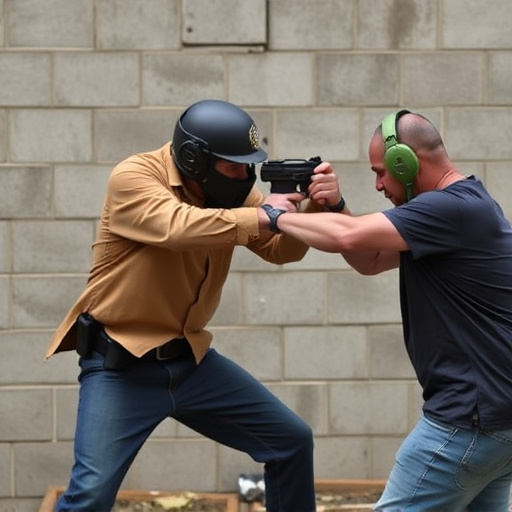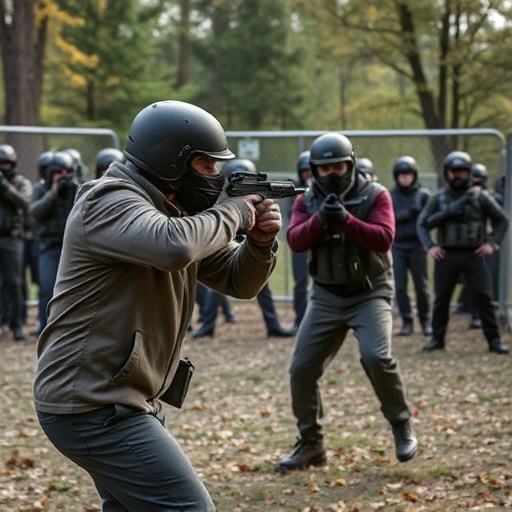Understanding electrical principles is key when using rechargeable stun devices for sale, which rely on voltage, amperage, and resistance to deliver targeted shocks. These devices use high-capacity lithium-ion batteries and circuit boards to control current flow and electrode activation, neutralizing targets with optimized voltage and amperage balance. Rechargeable batteries offer cost savings and convenience, while safety features like adjustable current output and overcurrent protection ensure responsible use and protect users and bystanders.
Discover the electrifying world of stun devices and their inner workings. From the basic electrical principles that set them in motion to the intricate components that enable current flow, this article demystifies these powerful tools. Explore the impact of voltage and amperage on performance, uncover the advancements in rechargeable batteries powering modern devices, and understand crucial safety mechanisms designed to control current flow. For those considering a purchase, knowledge is power—especially when it comes to rechargeable stun devices for sale.
- Understanding Basic Electrical Principles in Stun Devices
- Components That Facilitate Current Flow in Stun Guns
- The Role of Voltage and Amperage in Stun Device Performance
- Rechargeable Batteries: Powering Modern Stun Devices for Sale
- Safety Mechanisms: Controlling Current Flow in Stun Weapons
Understanding Basic Electrical Principles in Stun Devices

Understanding basic electrical principles is key when delving into the world of stun devices, especially when considering the popular option of rechargeable stun devices for sale. Stun guns, or electronic control devices (ECDs), operate on the principle of delivering an electric shock to disrupt muscle control in the target, causing temporary incapacitation. This is achieved through a complex interplay of voltage, amperage, and resistance.
The electrical current flow in these devices starts with the activation of the trigger, which initiates a circuit allowing electricity to pass from the battery or rechargeable power source through the output terminals and into the target. The intensity of the shock is determined by factors such as battery charge, contact area, and the device’s design. Understanding these principles helps users appreciate the importance of regular maintenance and responsible use when considering rechargeable stun devices for sale.
Components That Facilitate Current Flow in Stun Guns

Stun guns, or rechargeable stun devices for sale, rely on a complex interplay of components to facilitate the flow of electrical current during operation. At the heart of this process lies the battery, which serves as the power source. Modern stun devices often incorporate high-capacity lithium-ion batteries, known for their compact size and ability to deliver powerful currents. These batteries are connected to a circuit board that manages the flow of electricity, ensuring it reaches the output terminals efficiently.
The circuit board is strategically designed with specific components like diodes and resistors, which play crucial roles in controlling voltage levels and allowing current to flow unidirectionally. When the trigger is activated, the circuit completes a conductive path, enabling a sudden surge of electric current to pass through the stun device’s electrodes. This rapid discharge creates a powerful shock, temporarily disabling the target. Understanding these components and their interactions is key to appreciating the effectiveness of rechargeable stun devices in self-defense situations.
The Role of Voltage and Amperage in Stun Device Performance

The performance of a stun device is significantly influenced by two key factors: voltage and amperage. Voltage, measured in volts (V), represents the force behind the electrical current. Higher voltage in rechargeable stun devices for sale generally translates to more powerful shocks, as it increases the energy delivered per unit time. Amperage, or current, measured in amps (A), signifies the amount of charge flowing through the circuit. A higher amperage means a greater flow of electrons, resulting in a stronger and more immediate impact when used in stun devices.
The interplay between voltage and amperage determines the effectiveness of a stun device. While higher voltage can intensify the shock, ensuring adequate amperage is crucial to ensure the current flows effectively through the target. Balancing these two elements is essential in designing rechargeable stun devices for sale that offer both safety and optimal performance, making them reliable tools for self-defense or law enforcement purposes.
Rechargeable Batteries: Powering Modern Stun Devices for Sale

Rechargeable batteries have become a powering staple in modern stun devices for sale, marking a significant evolution from their non-reusable counterparts. This shift is driven by both environmental and economic considerations, as users increasingly seek sustainable alternatives. Rechargeable stun devices offer several advantages, not least of which is cost-effectiveness over the long term, eliminating the need for frequent battery replacements.
Moreover, these batteries enable users to stay prepared without constant worry about disposal or running out of power. With advanced charging technologies, modern rechargeable stun devices can be quickly and efficiently recharged, ensuring they’re always ready when needed. This convenience and sustainability make rechargeability a key feature in the market for stun devices, driving demand for these innovative products among folks prioritizing safety and environmental responsibility.
Safety Mechanisms: Controlling Current Flow in Stun Weapons

Safety mechanisms play a crucial role in rechargeable stun devices for sale, ensuring they are effective tools while minimizing risks to users and bystanders. These devices operate by delivering an electric current through electrodes, which can temporarily incapacitate a target. Advanced safety features have been integrated into modern stun guns and tasers to control the flow of electricity, preventing severe or accidental shocks.
One primary mechanism is the adjustable current output, allowing users to set the intensity according to their needs and level of training. This feature ensures that even inexperienced individuals can use the device responsibly without causing excessive harm. Additionally, smart circuits and overcurrent protection prevent the device from discharging at dangerous levels, safeguarding users from potential electrocution and reducing the risk of unintended injuries.
In summary, understanding the electrical current flow within stun devices is key to appreciating their design and functionality. From basic principles to advanced components, voltage, amperage, and rechargeable batteries all play pivotal roles in delivering effective stun performances. Moreover, safety mechanisms are crucial for controlling current flow, ensuring these powerful tools remain a reliable option for personal protection without compromising user safety. For those seeking modern, efficient self-defense solutions, exploring rechargeable stun devices for sale offers both enhanced convenience and peace of mind.
